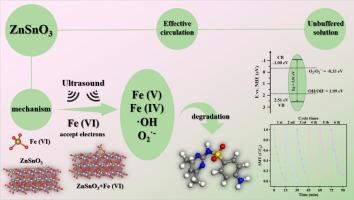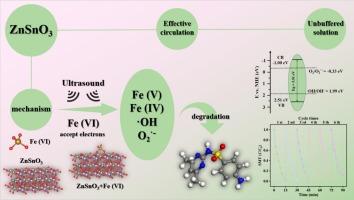ZnSnO3超声增强压电活化Fe(Ⅵ):一种在无缓冲溶液中降解磺胺类抗生素的新型有效策略
IF 13.2
1区 工程技术
Q1 ENGINEERING, CHEMICAL
引用次数: 0
摘要
磺胺类抗生素的过度使用对环境造成的影响日益严重,迫切需要一种有效和环境友好的解决方案。本研究提出了一种创新的ZnSnO3/Fe (VI)/US系统,该系统利用ZnSnO3的压电特性,通过超声波(US)激活,催化激活Fe (VI)。在短短15 min内,该系统实现了令人印象深刻的SMT降解率超过95 %,远远超过单个系统的性能。即使经过6次循环,降解效率仍保持在85 %以上。深入研究了超声和ZnSnO3在激活Fe (VI)中的协同作用机制,揭示了ZnSnO3中超声诱导极化如何促进电子向Fe (VI)转移,将其还原为驱动污染物降解的活性Fe (V)和Fe (IV)物质。这种新方法为磺胺的去除提供了一种新颖、环保的解决方案。此外,该系统可在超纯水中运行,无需传统的Fe (VI)活化缓冲溶液,为环境修复中的Fe (VI)活化提供了突破性的策略。本文章由计算机程序翻译,如有差异,请以英文原文为准。


Ultrasound-enhanced piezoelectric activation of Fe (Ⅵ) by ZnSnO3: A novel and efficient strategy for degrading sulfonamides antibiotics in unbuffered solutions
The environmental impact caused by the overuse of sulfonamide antibiotics is becoming increasingly severe, underscoring the urgent need for an effective and environmentally friendly solution. This study presents an innovative ZnSnO3/Fe (VI)/US system, which harnesses the piezoelectric properties of ZnSnO3, activated by ultrasound (US), to catalytically activate Fe (VI). In just 15 min, the system achieved an impressive degradation rate of over 95 % for SMT, far surpassing the performance of individual systems. Even after six cycles, the degradation efficiency remained above 85 %. The synergistic mechanism of ultrasound and ZnSnO3 in activating Fe (VI) was thoroughly investigated, revealing how ultrasound-induced polarization in ZnSnO3 facilitates electron transfer to Fe (VI), reducing it to reactive Fe (V) and Fe (IV) species that drive pollutant degradation. This new approach provides a novel, eco-friendly solution for sulfonamide removal. Moreover, the system operates in ultrapure water, eliminating the need for buffered solutions traditionally required in Fe (VI) activation, offering a groundbreaking strategy for Fe (VI) activation in environmental remediation.
求助全文
通过发布文献求助,成功后即可免费获取论文全文。
去求助
来源期刊

Chemical Engineering Journal
工程技术-工程:化工
CiteScore
21.70
自引率
9.30%
发文量
6781
审稿时长
2.4 months
期刊介绍:
The Chemical Engineering Journal is an international research journal that invites contributions of original and novel fundamental research. It aims to provide an international platform for presenting original fundamental research, interpretative reviews, and discussions on new developments in chemical engineering. The journal welcomes papers that describe novel theory and its practical application, as well as those that demonstrate the transfer of techniques from other disciplines. It also welcomes reports on carefully conducted experimental work that is soundly interpreted. The main focus of the journal is on original and rigorous research results that have broad significance. The Catalysis section within the Chemical Engineering Journal focuses specifically on Experimental and Theoretical studies in the fields of heterogeneous catalysis, molecular catalysis, and biocatalysis. These studies have industrial impact on various sectors such as chemicals, energy, materials, foods, healthcare, and environmental protection.
 求助内容:
求助内容: 应助结果提醒方式:
应助结果提醒方式:


